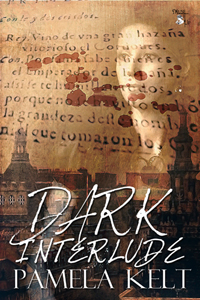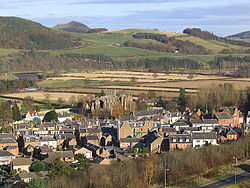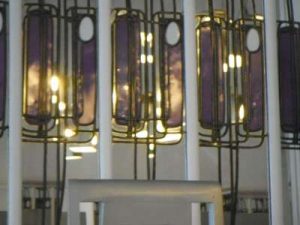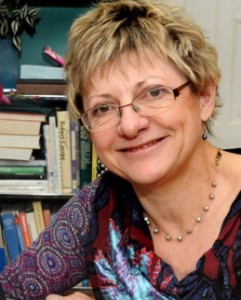 The Scottish Connection
The Scottish Connection
by
Pamela Kelt
Whenever I go on holiday, I have to make sure I have at least one A4 spiral-bound notepad and a batch of pens. Inspiration always seems to strike when I actually drag myself away from my much-loved clunky laptop.
Norway, Montenegro, the Czech Republic, Dublin … Wonderful places all, offering a wealth of plots, settings and characters.
However, the first book deal I landed was inspired by my home country, Scotland. Dark Interlude is a cross-genre historical mystery, that evolved into a rabble-rousing true-blue Scottish tale based on a real-life event and set in various locations that are all rather close to my heart.
With a name like Kelt (with a K), you will have guessed that I hail from north of the border. My family is Scottish to the core,  although I now live in England. There’s an apocryphal tale that my grandfather, the rather magnificent six-foot-four James Charles Kelt, keen fisherman and fly-maker, traced it back to earlier family in Dunblane who spelt it with a C. I have never found any proof, but I love the story. It makes me sound much more dangerous than I am, and I promise you, I don’t dangle the severed heads of my thwarted enemies on the porch. It would upset the postman.
although I now live in England. There’s an apocryphal tale that my grandfather, the rather magnificent six-foot-four James Charles Kelt, keen fisherman and fly-maker, traced it back to earlier family in Dunblane who spelt it with a C. I have never found any proof, but I love the story. It makes me sound much more dangerous than I am, and I promise you, I don’t dangle the severed heads of my thwarted enemies on the porch. It would upset the postman.
My mother’s side of the family hail from Musselburgh. I myself was born in Edinburgh. Although my parents moved to England to find work, as many Scots did in the 1950s, I do not consider myself English one jot.
Back to the book. The story features a young archivist in the late autumn of 1918 after Armistice. Demobbed soldiers are pouring back into Britain and her job is at risk. To prove herself, she is obliged to take on the onerous task of cataloguing a rare bequest.

This idea sprang from my personal fascination with 17th-century Spanish drama. This might sound rather academic, and I suppose it is. I’d always fancied trying my hand at writing a novel based on a thesis I researched at Oxford more years ago than I care to recall. ‘Aspects of comedy in the dramatic interludes of Luis Quiñones de Benavente.’ It was much more fun than it sounds. Think subversive humour, satire, censorship, theory of comedy, Aristotle, wit and commedia dell’arte farce. There were more corollaries than I ever imagined once I’d settled on the story, which has a strong political bent.
Meanwhile, I pondered the character and suddenly decided she had to be Scottish, perhaps because my own grandmother was quite the bluestocking in her day. She completed a degree in modern languages at the University of Glasgow in the early 1920s. (I recently acquired the degree certificate itself.) Although I live in England, I visit Scotland as often as possible, for I
love the place – villages, towns, cities, wilderness. As I get older, I think I love it more. Perhaps it’s some deep psychological yearning – you know those romantic Celts. I still get a frisson when I cross the border. ‘Scotland welcomes you,’ says the sign. I love it.
 The character Alexandra Milton is named after two villages near Loch Lomond where we spent a delightful family holiday with our two daft rescue dogs. It rained solidly, of course, but we didn’t care. The scenery and flora were fabulous – and the autumn colours tremendously romantic. The lochside walks featured in the books will be familiar to the many ramblers who visit this idyllic place just an hour’s drive from Glasgow.
The character Alexandra Milton is named after two villages near Loch Lomond where we spent a delightful family holiday with our two daft rescue dogs. It rained solidly, of course, but we didn’t care. The scenery and flora were fabulous – and the autumn colours tremendously romantic. The lochside walks featured in the books will be familiar to the many ramblers who visit this idyllic place just an hour’s drive from Glasgow.
But which university library should Alexandra work at? Following in her grandfather’s footsteps, my daughter is now at the University of Edinburgh. Before she went, we did the parental thing and traipsed around, forgive me, toured half a dozen of her top choices, including St Andrews. We flew to Edinburgh and I hired a tiny car with an engine slightly smaller than the one on my sewing machine and off we went. It was early February and snow had just fallen. A dense fog had rolled in off the North Sea and we had no idea what to expect. We crested a hill, rather slowly and in first gear, and there it was. St Andrews has the most beautiful skyline, with solid, stone-built edifices, elegant streets, rocky coastline – and rather a wonderful botanic garden that few seem to visit. So, I had my starting point for Alexandra, although I did redub the  institution St Peter’s.
institution St Peter’s.
In the story, the benefactress lives in a lodge by the side of a loch. If you’ve ever been to Loch Lomond, or any of the great Scottish lochs, you’ll have seen the type of place – often double-gabled, made out of sandstone, and created in perfect proportion with views and fishing rights to die for.
The town I named Argyle, a mishmash of Argyll as in the county and Argyle Street in Glasgow. It’s actually a cross between Crianlarich, that tiny town on the west coast railway, north of Glasgow, and Melrose, one of the famous border towns. To my shame, I’d never explored the borders until my daughter started at Edinburgh. It’s a perfect stop-off for anxious parents wanting to help, but diligently keeping their distance. Each of the towns has a giant abbey, but I refrained from adding an abbey to Argyle for it would have suggested the wrong side of the country to most Scots. These towns look the same as they did in the days of Dr Finlay’s Casebook: quaint stone houses with thick walls and tiny front gardens, dainty teashops, ornate fountains, opulent banks at the centre and dour churches on every street.
However, the story then moves to Glasgow, as Alexandra unearths an intriguing mystery. Here I have to make the most terrible admission. When I wrote the Glasgow chapters, I’d never actually been there. Shock horror. I’d changed trains there in my youth, but that was it.
So, time for some online research. Guilt drove me to spend hours and hours mapping out the events. I printed out a map of the city to make sure I knew all the key locations. Online street views helped me to retrace the steps of my characters to and fro, assessing how long it might take to walk, run or take the tram. I rummaged around some great local history websites, some filled with nostalgic pictures of the Clyde in the early 1900s, others crammed with old newspaper cuttings from local papers from that era. I even resorted to Youtube, God save me, to make sure I knew what an early 20th-century crane actually sounded like. It clanked.
Would I have done so much if I weren’t born in Edinburgh? Perhaps not! Ironically, my home city does make a brief appearance. Alexandra just changes trains there. The idea made me smile.
Finally, I finished the story and sent it off. A few weeks later, I went on a short trip with my husband. He’d been invited to give a talk at … you guessed it, Glasgow. I went sightseeing, double-checking my facts, wondering if the manuscript would ever see the light of day. I visited the university, walked along the Clyde, crossed the bridges, strolled through the botanic gardens,  Sauchiehall Street – and lunched at the Willow Tea Rooms, designed by Charles Rennie Mackintosh. It was fine. Big sigh of relief.
Sauchiehall Street – and lunched at the Willow Tea Rooms, designed by Charles Rennie Mackintosh. It was fine. Big sigh of relief.
Imagine my surprise when I checked my emails upon my return to Warwickshire. In a quirk of fate, I discovered my manuscript had been accepted. My first! While I’d been discovering the delights of Glasgow, the email had been sitting in my inbox awaiting my return.
Since then, my stepmother and her husband have moved north of the border as well to an undisclosed location in Dumfries and Galloway. It seemed appropriate to dedicate the book to them ‘on their very own Scottish adventure’. I’m now the only member of the family still living in England. However, I’m already planning the sequel
to Dark Interlude, for I’ve realised that writing about Scotland stops me from feeling homesick.
http://www.youtube.com/watch?v=8evlj94c37Q
Dark Interlude is out on MuseItUp Publishing on 21 June. Find out more the Dark Interlude website.
Click here to see the video trailer, and here to see the scrapbook of the story. Sample part of Chapter One here.
 Short bio:
Short bio:
Born in Edinburgh, I have two degrees in Spanish (Manchester and Oxford), specialising in 17th-century comic drama. I trained in journalism, including stints on provincial newspapers in Bath, Bristol, Cambridge and Lancashire as well as Western Australia. I moved into educational publishing and online editing including international publishers and Government agencies. I now live in Warwickshire where I started to write full-time to avoid the ‘empty nest’ syndrome. To my delight, I now have six book deals.
Newsroom thriller Tomorrow’s Anecdote (Crooked Cat) was released in April. It is set in a newsroom during the turbulent Thatcher years.
Half Life: a 1930s ‘film noir’-style thriller set in Norway in the dark days before the invasion as scientists race to solve the mystery of nuclear fission. This was co-written with my Tasmanian-born husband, Robert Deeth, a professor of inorganic chemistry at the University of Warwick. (August on Muse)
The Lost Orchid: a Gothic inspired mystery adventure inspired by the exploits of Scottish plant collectors, featuring Flora McPhairson. (This summer on Bluewood Publishing)
Ice Trekker: a teen fantasy set in the icy wilds of Krønagar. (September on Muse)
The Cloud Pearl: a teen adventure telling of the battle against the vile Grax dynasty, and part one of Legends of Liria.
In addition, I run Orchidmania, a botanical blog for orchid enthusiasts, having become somewhat addicted doing the research for The Lost Orchid.
Links:
Follow me on Twitter and Facebook. Find out all the latest on my author website and blog. Or why not send an email to pamkelt@gmail.com?
See her author pages on Amazon.co.uk, Amazon.com, Goodreads and Smashwords.






